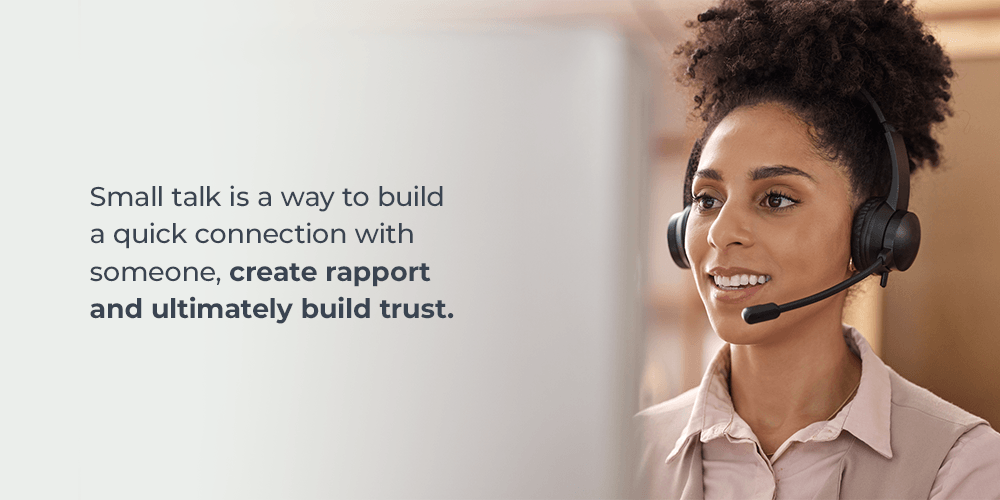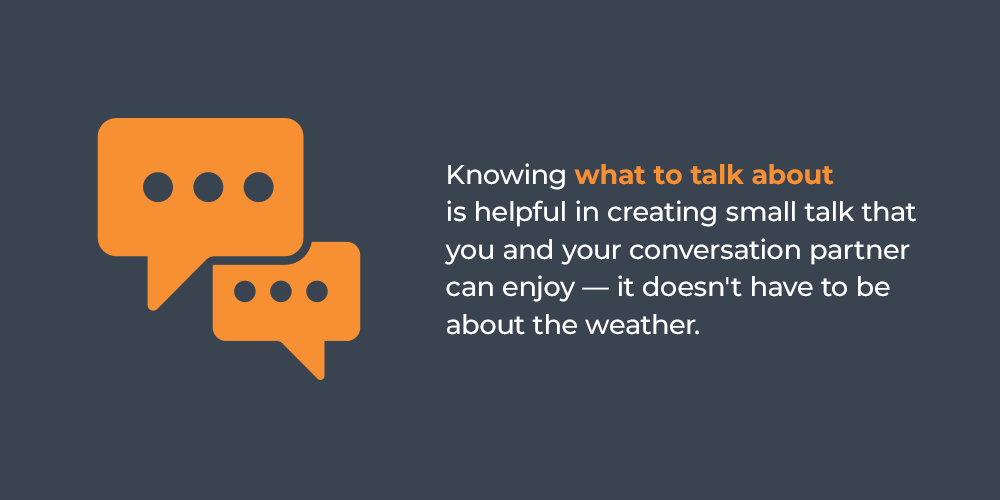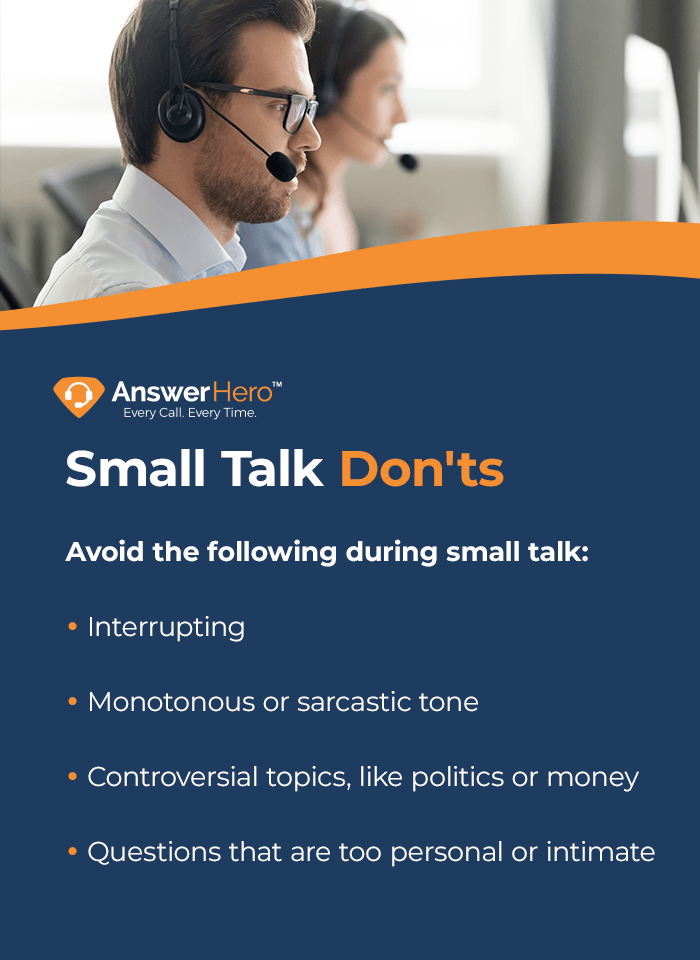The Ultimate Guide to Small Talk on the Phone
We’ve all been in a position where we had to engage in small talk — whether it’s a dental hygienist during a checkup or an acquaintance at the grocery store. Small talk is a big part of being human, and it especially plays a role in the professional world. In particular, phone conversation might be one of the most common times you engage in small talk.
Prepare yourself for your next phone call with this small talk guide.
Why Small Talk Matters
Small talk is an important player in building rapport personally and professionally. Rapport is a sense of harmony in a relationship, and it can be established with coworkers, clients, new friends or anybody else you interact with regularly. Small talk is a way to build a quick connection with someone, create rapport and ultimately build trust.

We can also use small talk to help navigate discomfort in social situations. Meeting someone new isn’t always easy, and it can be uncomfortable for both people involved. Finding a lighthearted subject to chat about forms common ground and helps both parties overcome any nervousness related to a first impression.
Building this sense of comfort is also valuable for transitioning to deeper topics that require more openness. In your personal life, these deeper conversations form stronger friendships. In the business world, this sense of transparency is important for addressing a client’s hesitation related to a product or service and holding more meaningful conversations about goals and needs.
Getting down to business is necessary in the professional world at times, but taking a moment to form a personal connection with a client, lead or colleague can make a huge difference to the quality of your professional relationships.
Mastering the Art of Starting a Conversation
Starting a conversation is the first step in getting comfortable with small talk. Before you make your call, prepare yourself for the conversation. It can be easy to put too much pressure on yourself before you call up a lead or client, but you need to give yourself space to relax. Think positively and remind yourself that you’re capable. Think of this as a chance to form a human connection and nothing more. If you keep the idea of making a sale at the forefront, you might find it more challenging to relax.
Once you’ve taken time to loosen up, consider how you’ll open the call. A quick greeting is always a great place to start and then think of a solid question to ask. While “How are you?” is common, it doesn’t often open the door for conversation. A better question can be, “What have you been up to today?” This question gives your conversation partner a chance to talk about their work or personal life, and can lead to more questions.
For example, your conversation partner might mention they’ve had a busy day preparing for a trade show next week. Use this opportunity to ask questions about the show and what your conversation partner likes about their job. It’s helpful to make your initial question an open-ended one, so you get more details and pave the way for more questions. Before you know it, you’ll establish a natural back and forth over the phone.
Navigating Topics for Engaging Small Talk

Knowing what to talk about helps create small talk that you and your conversation partner can enjoy — it doesn’t have to be about the weather. Here are some common small talk conversation topics:
- Career: Questions about a person’s job are often easier to address in a professional context, especially if you’re still developing your confidence with small talk. Ask about when your conversation partner started working at their current job, what they like about the role and if they have any fun work stories.
- Lifestyle: You can make conversations lighthearted with non-work-related questions, such as, “What are your hobbies?” or “Do you have any fun plans coming up?”
- Food: Everybody eats! Food is a great topic to connect on, whether you’re asking about their favorite restaurant in the area or recalling a delicious meal you had recently.
- Travel: Travel questions can be a natural extension to lifestyle questions, especially if your conversation partner talks about an upcoming trip. You can share some of your favorite vacation spots and ask them about theirs. These questions might also touch on bucket list locations.
- Entertainment: We consume media every day, and we all have something to share about it. You might talk about a show you’re currently watching and ask them what some of their favorite shows are. Other topics to chat about include books, new movies and favorite phone apps.
Sharing something from your life in any of these topics can be an easy way to transition to questions for your conversation partner. After your greeting, you can open up by talking about something like a recent trip you went on to ease into the interaction.
Active Listening and Showing Genuine Interest
To make small talk, you need to practice active listening to engage with the conversation fully. Helpful tips for active listening include:
- Avoid interrupting: Give your conversation partner the space to say their piece before you add your thoughts. When talking on the phone, it can be a little harder to tell when a person is done talking. If you interrupt by accident, you can always apologize and tell them to continue.
- Paraphrase: Repeating what someone has said through a brief summary is a way to indicate you’ve been listening. You can also do this by referencing something earlier in the conversation. For example, if your conversation partner brings up a trip they’re going to take, you can talk about how that will be fun for their kids as a callback to when you talked about family earlier.
- Stay curious: Showing genuine interest is one of the best ways to show you’re listening. Put your professional goals on the back burner for a moment to focus on the conversation you’re having right now. Ask questions to learn more about the things that interest you the most.
Body Language and Nonverbal Cues
As with any conversation, body language and nonverbal cues will play a role. When it comes to small talk on the phone, however, these factors will be a little different than how they are in person. Since you’re not seeing the person, you won’t be able to take in information through posture and eye contact. Fortunately, you also won’t have to think about these factors on your end.
The biggest nonverbal cues to think about over the phone are tone of voice, speaking volume and inflection. You’ll want to talk at a normal volume like you’re having a conversation with a friend in the room. Talking too quietly can make communication more challenging on the phone. Your tone and inflection also need to remain genuine and friendly. It’s best to avoid overly sarcastic tones that your conversation partner may not be able to pick up on.
Remember to smile when you talk, too! We can actually hear a smile based on the sound of someone’s voice, so don’t hesitate to talk on the phone with a grin. Studies have also shown that smiling is a helpful practice for regulating emotions. If you’re feeling nervous before your call, smiling may make the feeling easier to manage.
Handling Awkward Moments
Every now and then, you might encounter some awkward moments in your phone conversations, especially when you’re learning how to use small talk. The first thing to keep in mind is that awkward moments are very human, and there’s no shame in having them. Whether you experience some extended silence or fumble over your speech, try these tips to navigate awkwardness:
- Keep the conversation moving: When an awkward moment happens, lingering on it can extend the discomfort. Consider it a small hiccup and move forward with a new question or point. The less space you give an awkward moment, the less memorable it becomes.
- Look for the humor: A long silence or tripping over your words might feel uncomfortable, and we’ve all had moments like this. It’s okay to laugh at yourself and point out the obvious. Saying “Looks like I’m a little tongue-tied today!” can be a great way to lighten the conversation and connect back to human experiences.
- Ask for clarity: Sometimes awkward moments happen when there’s a little tension in the conversation. This tension will often occur when there’s a misunderstanding. In these moments, the best thing you can do is ask for additional clarity. If you feel like your message isn’t getting across, you can take a moment to confirm what your conversation partner is saying, then break down your thoughts a little further.

Moving Beyond Surface-Level Conversations
Small talk, by definition, is surface-level, but when you call a client or lead, you likely have a goal in mind. While you might start your phone call with some small talk, you need to transition to the point of the call. You might lose time for the important stuff if you chat too much.
When you’re ready to transition into your main conversation, wait for a natural time to do so. Rather than interrupting your conversation partner, use your time to speak to bring up the goal of the call. You can transition with a statement like, “As much as I’d love to keep chatting, I do have some other points I wanted to touch on while I have you on the phone.”
You can make sure the conversation moves on by reminding your conversation partner that you want to be respectful of their time. This is a helpful way to show that you’re not rushing them and understand they have other things to do.
Using Small Talk for Professional Networking
Great news — once you continually practice small talk on the phone, you can apply it in all types of professional settings. Since small talk is a wonderful way to build rapport, it’s an excellent tool for professional networking. Whether you’re at a trade show, attending a networking event or interacting with someone who may be an excellent client, small talk helps get your foot in the door.
For example, if you’re at a trade show, you might meet someone from another business who can benefit from your services. You can jump-start the conversation by commenting on where they’re from or complimenting something at their stand to get the conversation flowing. From there, use your toolkit of small talk skills to build a connection and transition to your proposition.
Practicing and Building Confidence
At the end of the day, small talk is a skill, just like painting, playing the trumpet or using carpentry tools. It’s okay to feel like your small talk is clunky or awkward when you first start doing it. The more you engage in small talk, the more natural it will feel.
The key to small talk is trusting yourself to respond in the moment. If you’re not used to engaging in small talk, you won’t feel that trust as strongly. As you navigate these conversations, you’ll steadily build your confidence and become a small talk pro.
Your best friend during this learning experience is finding ways to stay calm before getting on the phone. The looser you feel, the easier you’ll be able to move with the conversation. Feel free to practice some deep breathing before you make a phone call, so you feel relaxed before you start chatting.
Small Talk Dos and Don’ts
Small talk can be challenging for everyone, especially over the phone. Between nonverbal cues, managing awkward moments and building confidence, you can handle small talk with ease. Stay on top of all the best practices for small talk with a comprehensive list of dos and don’ts.

Dos
When engaging in small talk, do the following:
- Treat your conversation partner like a friend
- Stay loose and be gentle with yourself
- Smile
- Turn to topics that are lighthearted and relatable
- Keep language informal, but polite
- Ask questions and stay curious
- Be an active listener
Don’ts
Avoid the following during small talk:
- Interrupting
- Monotonous or sarcastic tone
- Controversial topics, like politics or money
- Questions that are too personal or intimate
Turn to the Small Talk Experts at AnswerHero™
AnswerHero™ is a call answering service that supports all types of businesses with busy phone lines. Our trained virtual receptionists are small talk experts who know how to build rapport with your callers and create a positive reputation for your business.
With our virtual receptionist service, you can create a branded greeting for our agents and benefit from a range of over-the-phone solutions. Our receptionists handle processes like message taking, appointment setting and call transfers, so you can practice your own small talk skills. With 100% bilingual agents, every caller can be heard.
Our services are contract-free and offer flexible pricing options to fit your company’s needs. Get in touch with us today, and get started with our quick and easy onboarding process.
